ECO10250 Economics for Decision Making Assignment - SCU Solution
VerifiedAdded on 2023/06/10
|15
|1654
|128
Homework Assignment
AI Summary
This document presents a detailed solution to an economics assignment focusing on decision-making principles. It covers various topics, including production possibility curves, opportunity cost, market equilibrium, and the impact of taxes on industries like coal and solar power. The solution also delves into consumer and producer surplus, price elasticity of demand, and cost analysis for firms, including the concepts of total cost, marginal cost, and profit maximization in a competitive market. The assignment uses graphs and calculations to illustrate economic concepts and provide answers to specific questions related to supply, demand, and market interventions.

Running Head: ECONOMICS FOR DECISION MAKING
Economics for Decision Making
Name of the Student
Name of the University
Course ID
Economics for Decision Making
Name of the Student
Name of the University
Course ID
Paraphrase This Document
Need a fresh take? Get an instant paraphrase of this document with our AI Paraphraser
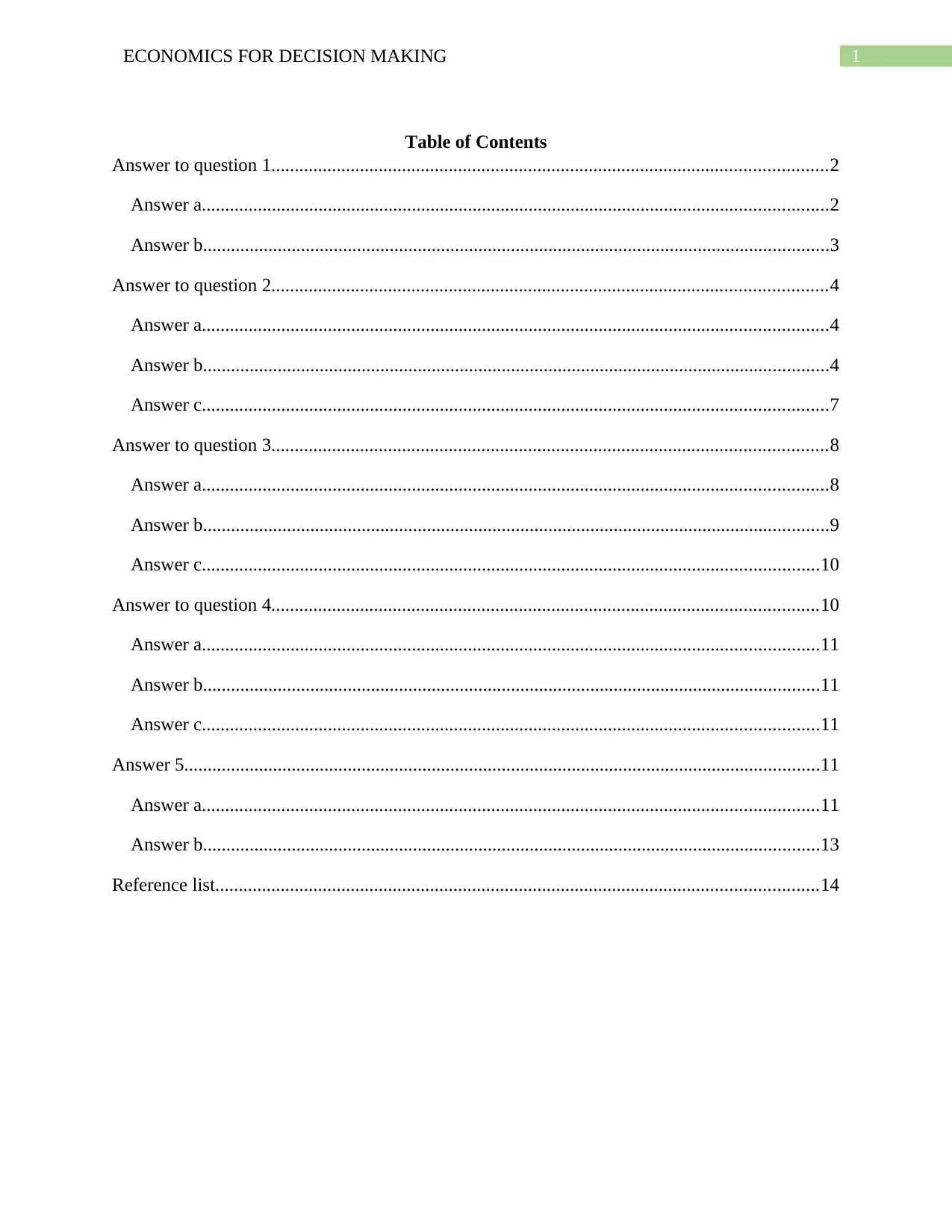
1ECONOMICS FOR DECISION MAKING
Table of Contents
Answer to question 1.......................................................................................................................2
Answer a......................................................................................................................................2
Answer b......................................................................................................................................3
Answer to question 2.......................................................................................................................4
Answer a......................................................................................................................................4
Answer b......................................................................................................................................4
Answer c......................................................................................................................................7
Answer to question 3.......................................................................................................................8
Answer a......................................................................................................................................8
Answer b......................................................................................................................................9
Answer c....................................................................................................................................10
Answer to question 4.....................................................................................................................10
Answer a....................................................................................................................................11
Answer b....................................................................................................................................11
Answer c....................................................................................................................................11
Answer 5........................................................................................................................................11
Answer a....................................................................................................................................11
Answer b....................................................................................................................................13
Reference list.................................................................................................................................14
Table of Contents
Answer to question 1.......................................................................................................................2
Answer a......................................................................................................................................2
Answer b......................................................................................................................................3
Answer to question 2.......................................................................................................................4
Answer a......................................................................................................................................4
Answer b......................................................................................................................................4
Answer c......................................................................................................................................7
Answer to question 3.......................................................................................................................8
Answer a......................................................................................................................................8
Answer b......................................................................................................................................9
Answer c....................................................................................................................................10
Answer to question 4.....................................................................................................................10
Answer a....................................................................................................................................11
Answer b....................................................................................................................................11
Answer c....................................................................................................................................11
Answer 5........................................................................................................................................11
Answer a....................................................................................................................................11
Answer b....................................................................................................................................13
Reference list.................................................................................................................................14

2ECONOMICS FOR DECISION MAKING
Answer to question 1
Answer a
i)
0 10 20 30 40 50 60 70 80 90
0
10
20
30
40
50
60
70
Producti on Possibiliti es
Grade
Works per hour
Figure 1: Production possibility curve of Joan
ii)
Opportunity cost is said to be increasing when people has to sacrifice more and more units of one
commodity to have one additional unit of other (Mankiw 2014). For Joan, increasing grades
involves sacrifice of more and more hours of work per week. For example, first 20 percent grade
has an opportunity cost of 5 work hours. The opportunity cost for grade of 40, 60, 80 are 10, 15
and 30 respectively which shows an increase in opportunity cost for a higher and higher grade.
iii)
A constant opportunity cost for grades produce a linear production possibility curve as shown in
figure 2
Answer to question 1
Answer a
i)
0 10 20 30 40 50 60 70 80 90
0
10
20
30
40
50
60
70
Producti on Possibiliti es
Grade
Works per hour
Figure 1: Production possibility curve of Joan
ii)
Opportunity cost is said to be increasing when people has to sacrifice more and more units of one
commodity to have one additional unit of other (Mankiw 2014). For Joan, increasing grades
involves sacrifice of more and more hours of work per week. For example, first 20 percent grade
has an opportunity cost of 5 work hours. The opportunity cost for grade of 40, 60, 80 are 10, 15
and 30 respectively which shows an increase in opportunity cost for a higher and higher grade.
iii)
A constant opportunity cost for grades produce a linear production possibility curve as shown in
figure 2
⊘ This is a preview!⊘
Do you want full access?
Subscribe today to unlock all pages.

Trusted by 1+ million students worldwide
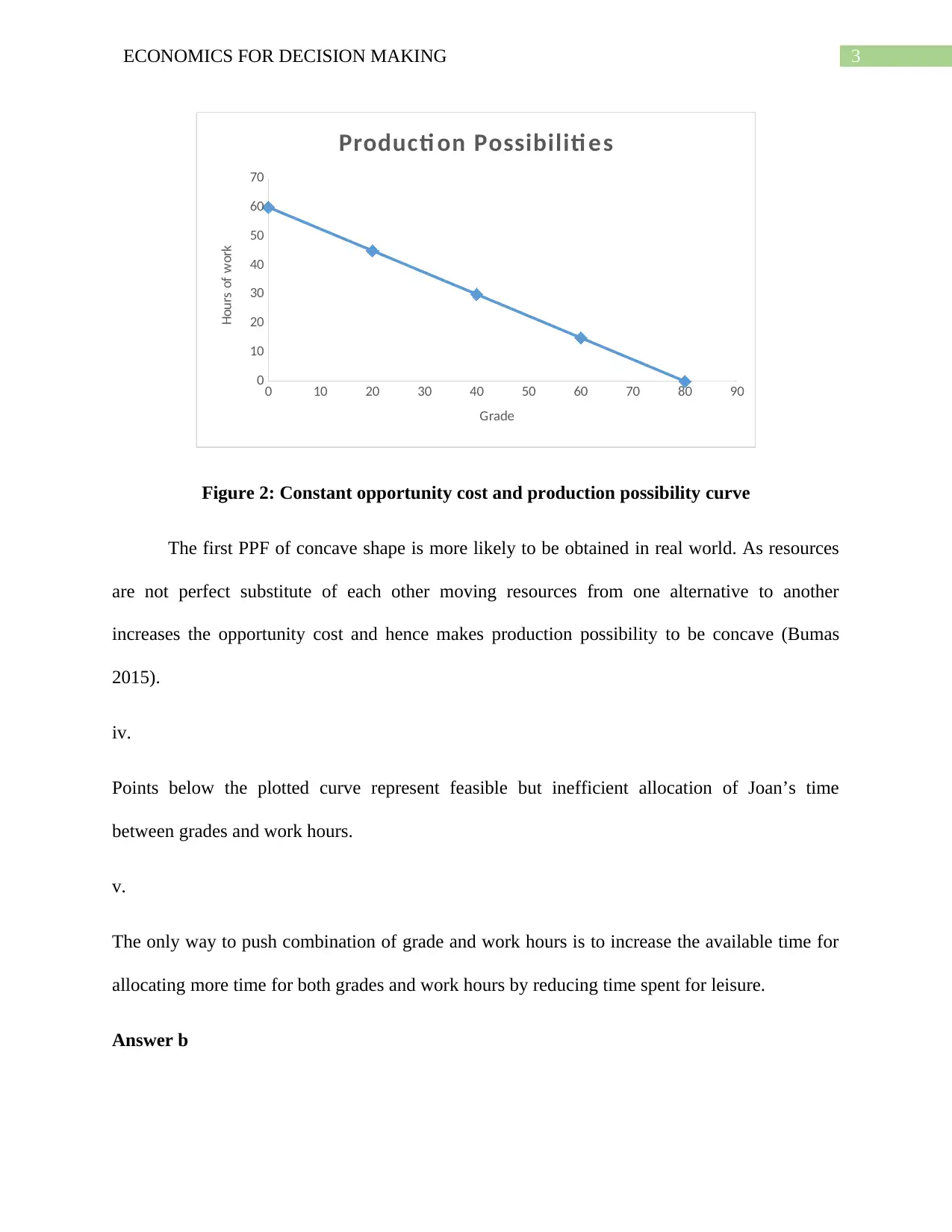
3ECONOMICS FOR DECISION MAKING
0 10 20 30 40 50 60 70 80 90
0
10
20
30
40
50
60
70
Producti on Possibiliti es
Grade
Hours of work
Figure 2: Constant opportunity cost and production possibility curve
The first PPF of concave shape is more likely to be obtained in real world. As resources
are not perfect substitute of each other moving resources from one alternative to another
increases the opportunity cost and hence makes production possibility to be concave (Bumas
2015).
iv.
Points below the plotted curve represent feasible but inefficient allocation of Joan’s time
between grades and work hours.
v.
The only way to push combination of grade and work hours is to increase the available time for
allocating more time for both grades and work hours by reducing time spent for leisure.
Answer b
0 10 20 30 40 50 60 70 80 90
0
10
20
30
40
50
60
70
Producti on Possibiliti es
Grade
Hours of work
Figure 2: Constant opportunity cost and production possibility curve
The first PPF of concave shape is more likely to be obtained in real world. As resources
are not perfect substitute of each other moving resources from one alternative to another
increases the opportunity cost and hence makes production possibility to be concave (Bumas
2015).
iv.
Points below the plotted curve represent feasible but inefficient allocation of Joan’s time
between grades and work hours.
v.
The only way to push combination of grade and work hours is to increase the available time for
allocating more time for both grades and work hours by reducing time spent for leisure.
Answer b
Paraphrase This Document
Need a fresh take? Get an instant paraphrase of this document with our AI Paraphraser
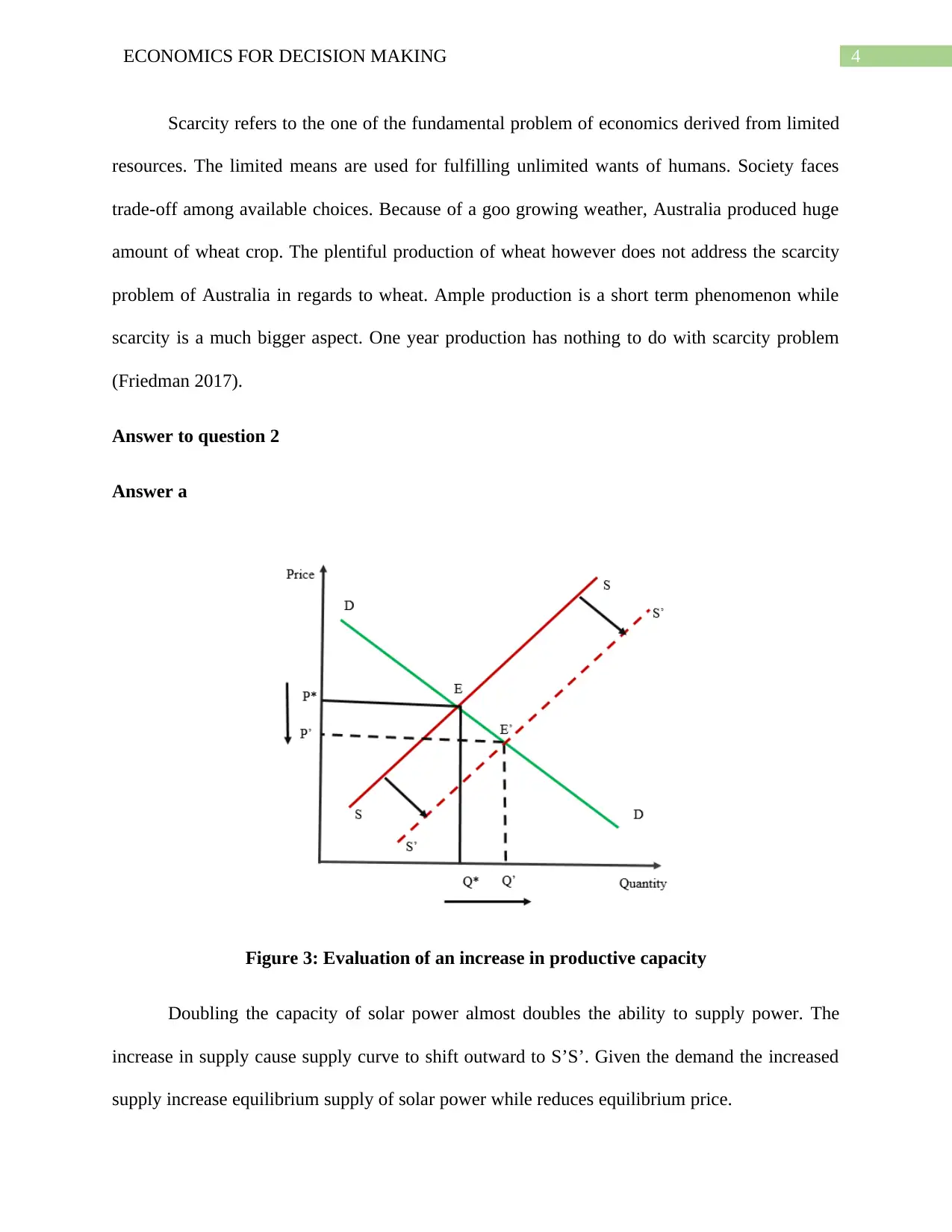
4ECONOMICS FOR DECISION MAKING
Scarcity refers to the one of the fundamental problem of economics derived from limited
resources. The limited means are used for fulfilling unlimited wants of humans. Society faces
trade-off among available choices. Because of a goo growing weather, Australia produced huge
amount of wheat crop. The plentiful production of wheat however does not address the scarcity
problem of Australia in regards to wheat. Ample production is a short term phenomenon while
scarcity is a much bigger aspect. One year production has nothing to do with scarcity problem
(Friedman 2017).
Answer to question 2
Answer a
Figure 3: Evaluation of an increase in productive capacity
Doubling the capacity of solar power almost doubles the ability to supply power. The
increase in supply cause supply curve to shift outward to S’S’. Given the demand the increased
supply increase equilibrium supply of solar power while reduces equilibrium price.
Scarcity refers to the one of the fundamental problem of economics derived from limited
resources. The limited means are used for fulfilling unlimited wants of humans. Society faces
trade-off among available choices. Because of a goo growing weather, Australia produced huge
amount of wheat crop. The plentiful production of wheat however does not address the scarcity
problem of Australia in regards to wheat. Ample production is a short term phenomenon while
scarcity is a much bigger aspect. One year production has nothing to do with scarcity problem
(Friedman 2017).
Answer to question 2
Answer a
Figure 3: Evaluation of an increase in productive capacity
Doubling the capacity of solar power almost doubles the ability to supply power. The
increase in supply cause supply curve to shift outward to S’S’. Given the demand the increased
supply increase equilibrium supply of solar power while reduces equilibrium price.
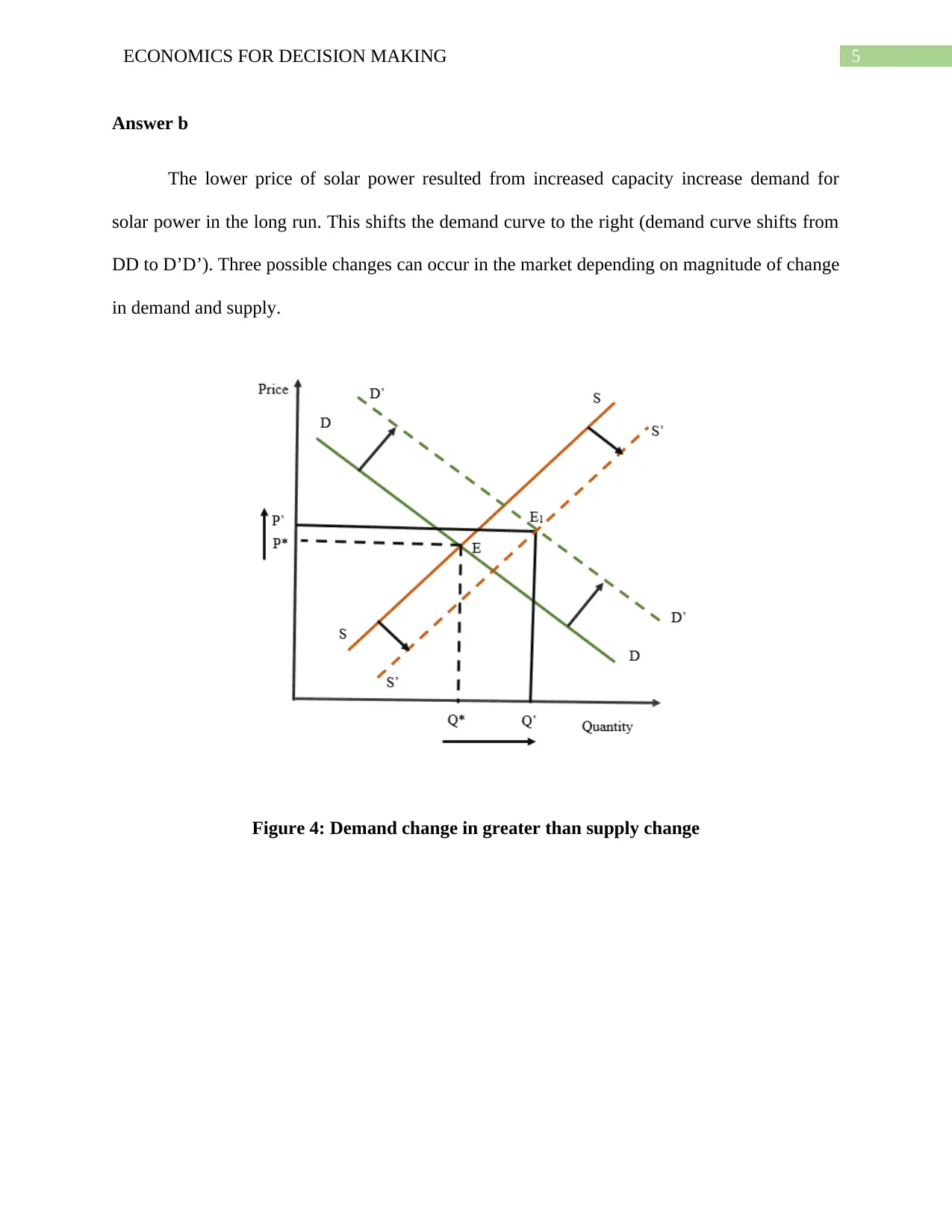
5ECONOMICS FOR DECISION MAKING
Answer b
The lower price of solar power resulted from increased capacity increase demand for
solar power in the long run. This shifts the demand curve to the right (demand curve shifts from
DD to D’D’). Three possible changes can occur in the market depending on magnitude of change
in demand and supply.
Figure 4: Demand change in greater than supply change
Answer b
The lower price of solar power resulted from increased capacity increase demand for
solar power in the long run. This shifts the demand curve to the right (demand curve shifts from
DD to D’D’). Three possible changes can occur in the market depending on magnitude of change
in demand and supply.
Figure 4: Demand change in greater than supply change
⊘ This is a preview!⊘
Do you want full access?
Subscribe today to unlock all pages.

Trusted by 1+ million students worldwide

6ECONOMICS FOR DECISION MAKING
Figure 5: Demand change in smaller than supply change
Figure 6: Change in demand equals change in supply
Figure 5: Demand change in smaller than supply change
Figure 6: Change in demand equals change in supply
Paraphrase This Document
Need a fresh take? Get an instant paraphrase of this document with our AI Paraphraser
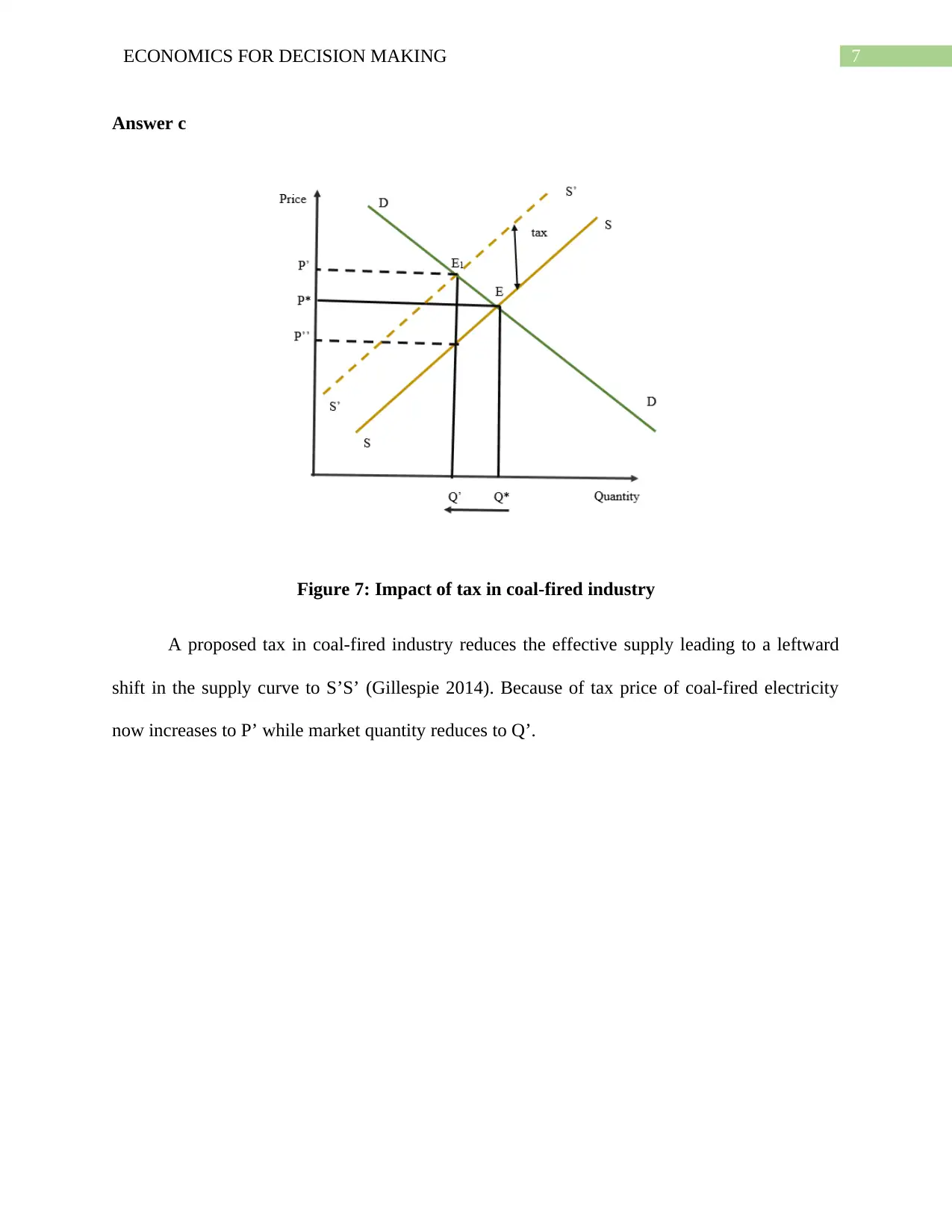
7ECONOMICS FOR DECISION MAKING
Answer c
Figure 7: Impact of tax in coal-fired industry
A proposed tax in coal-fired industry reduces the effective supply leading to a leftward
shift in the supply curve to S’S’ (Gillespie 2014). Because of tax price of coal-fired electricity
now increases to P’ while market quantity reduces to Q’.
Answer c
Figure 7: Impact of tax in coal-fired industry
A proposed tax in coal-fired industry reduces the effective supply leading to a leftward
shift in the supply curve to S’S’ (Gillespie 2014). Because of tax price of coal-fired electricity
now increases to P’ while market quantity reduces to Q’.

8ECONOMICS FOR DECISION MAKING
Figure 8: Evaluation of tax in solar power industry
In response to increased price of coal fired electricity because of imposed tax, demand for
solar powered electricity increases. This causes demand curve in the solar power industry to shift
outward leading to an expansion of both price and quantity in the industry.
Answer to question 3
Answer a
The difference between maximum willing price of a consumer actual price that the
consumer pays for the good is called consumer surplus. Surplus earned by producers because of
the difference between market price and minimum supply price is called producer surplus.
Figure 8: Evaluation of tax in solar power industry
In response to increased price of coal fired electricity because of imposed tax, demand for
solar powered electricity increases. This causes demand curve in the solar power industry to shift
outward leading to an expansion of both price and quantity in the industry.
Answer to question 3
Answer a
The difference between maximum willing price of a consumer actual price that the
consumer pays for the good is called consumer surplus. Surplus earned by producers because of
the difference between market price and minimum supply price is called producer surplus.
⊘ This is a preview!⊘
Do you want full access?
Subscribe today to unlock all pages.

Trusted by 1+ million students worldwide

9ECONOMICS FOR DECISION MAKING
Figure 9: Consumer and Producer Surplus
Answer b
If the solar power capacity increases, then market price of solar power decreases. The
lower price increases consumer surplus as shown by the bigger triangle A’P’E’. Increase in
productive capacity implies a greater efficiency (Waldman and Jensen 2016). This results in a
greater cost efficiency leading to an increase in production surplus E’P’C’.
Figure 9: Consumer and Producer Surplus
Answer b
If the solar power capacity increases, then market price of solar power decreases. The
lower price increases consumer surplus as shown by the bigger triangle A’P’E’. Increase in
productive capacity implies a greater efficiency (Waldman and Jensen 2016). This results in a
greater cost efficiency leading to an increase in production surplus E’P’C’.
Paraphrase This Document
Need a fresh take? Get an instant paraphrase of this document with our AI Paraphraser
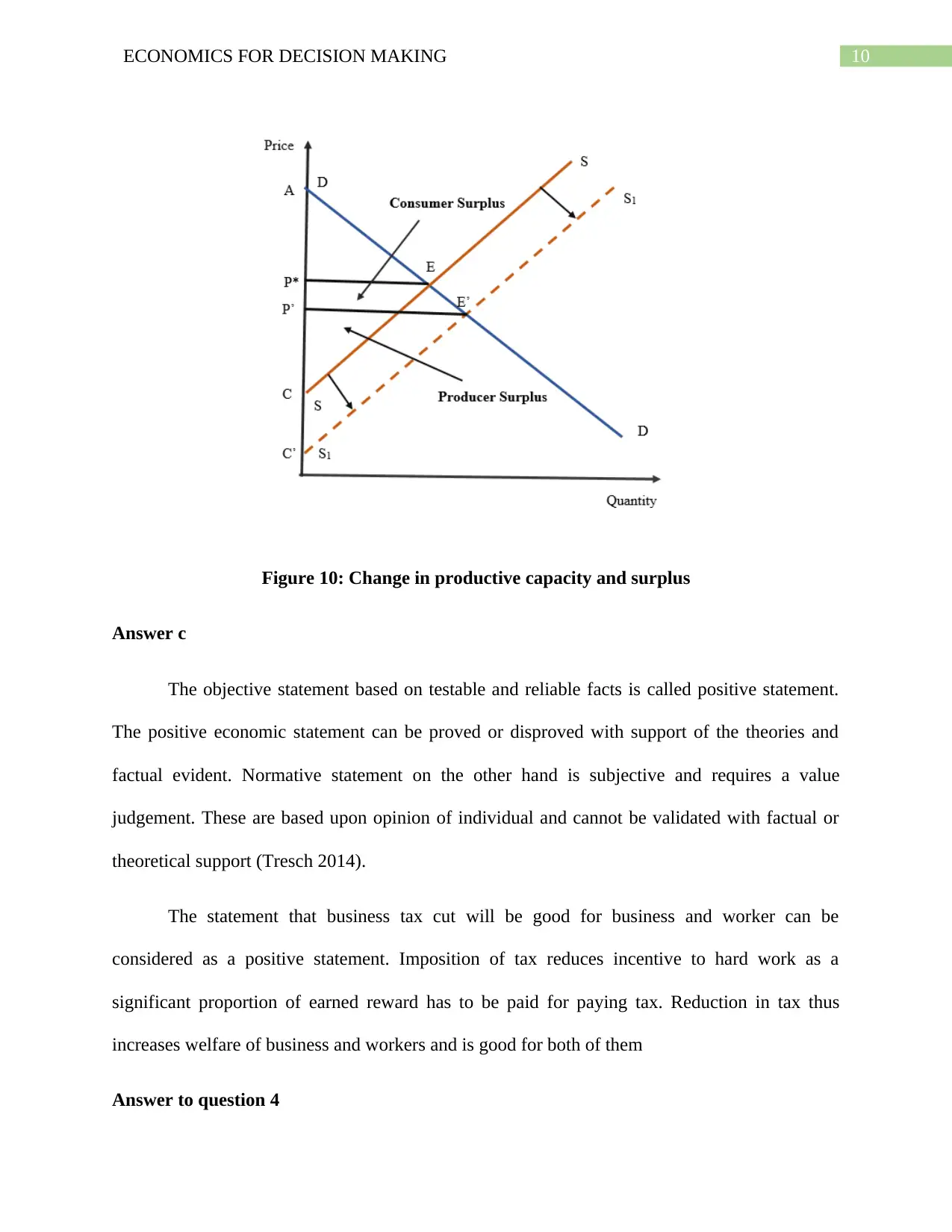
10ECONOMICS FOR DECISION MAKING
Figure 10: Change in productive capacity and surplus
Answer c
The objective statement based on testable and reliable facts is called positive statement.
The positive economic statement can be proved or disproved with support of the theories and
factual evident. Normative statement on the other hand is subjective and requires a value
judgement. These are based upon opinion of individual and cannot be validated with factual or
theoretical support (Tresch 2014).
The statement that business tax cut will be good for business and worker can be
considered as a positive statement. Imposition of tax reduces incentive to hard work as a
significant proportion of earned reward has to be paid for paying tax. Reduction in tax thus
increases welfare of business and workers and is good for both of them
Answer to question 4
Figure 10: Change in productive capacity and surplus
Answer c
The objective statement based on testable and reliable facts is called positive statement.
The positive economic statement can be proved or disproved with support of the theories and
factual evident. Normative statement on the other hand is subjective and requires a value
judgement. These are based upon opinion of individual and cannot be validated with factual or
theoretical support (Tresch 2014).
The statement that business tax cut will be good for business and worker can be
considered as a positive statement. Imposition of tax reduces incentive to hard work as a
significant proportion of earned reward has to be paid for paying tax. Reduction in tax thus
increases welfare of business and workers and is good for both of them
Answer to question 4

11ECONOMICS FOR DECISION MAKING
Answer a
Price
Quantity
Demanded
Total
Revenue
Percentage
change in
price
Percentage change
quantity demanded
Elasticity
Value
Assessment of
Elasticity
0.50 16 8
1.00 13 13 66.67% -20.69% -0.31
Relatively
inelastic
1.50 10 15 40.00% -26.09% -0.65
Relatively
inelastic
2.00 7 14 28.57% -35.29% -1.24
Relatively
elastic
2.50 4 10 22.22% -54.55% -2.45
Relatively
elastic
3.00 1 3 18.18% -120.00% -6.60 Highly Elastic
Answer b
The price elasticity of demand for hot doughnut is likely to be more elastic in summer as
compared to that in winter. Because of lesser demand of hot doughnuts in summer people can
easily adjust their demand for hot doughnuts in summer than that in winter. This makes demand
more elastic in summer (Moulin 2014).
Answer c
For addictive product like cigarette, people generally have a relatively inelastic demand
because of their inability to alter demand habit in response to price.
Answer 5
Answer a
i.
Out
put
Total
Fixed
Total
Variable
Total
Cost
Average
Total Cost
Margin
al Cost
Total
Revenu
Average
Revenue
Marginal
Revenue
Pro
fit
Answer a
Price
Quantity
Demanded
Total
Revenue
Percentage
change in
price
Percentage change
quantity demanded
Elasticity
Value
Assessment of
Elasticity
0.50 16 8
1.00 13 13 66.67% -20.69% -0.31
Relatively
inelastic
1.50 10 15 40.00% -26.09% -0.65
Relatively
inelastic
2.00 7 14 28.57% -35.29% -1.24
Relatively
elastic
2.50 4 10 22.22% -54.55% -2.45
Relatively
elastic
3.00 1 3 18.18% -120.00% -6.60 Highly Elastic
Answer b
The price elasticity of demand for hot doughnut is likely to be more elastic in summer as
compared to that in winter. Because of lesser demand of hot doughnuts in summer people can
easily adjust their demand for hot doughnuts in summer than that in winter. This makes demand
more elastic in summer (Moulin 2014).
Answer c
For addictive product like cigarette, people generally have a relatively inelastic demand
because of their inability to alter demand habit in response to price.
Answer 5
Answer a
i.
Out
put
Total
Fixed
Total
Variable
Total
Cost
Average
Total Cost
Margin
al Cost
Total
Revenu
Average
Revenue
Marginal
Revenue
Pro
fit
⊘ This is a preview!⊘
Do you want full access?
Subscribe today to unlock all pages.

Trusted by 1+ million students worldwide
1 out of 15
Related Documents
Your All-in-One AI-Powered Toolkit for Academic Success.
+13062052269
info@desklib.com
Available 24*7 on WhatsApp / Email
![[object Object]](/_next/static/media/star-bottom.7253800d.svg)
Unlock your academic potential
Copyright © 2020–2025 A2Z Services. All Rights Reserved. Developed and managed by ZUCOL.




